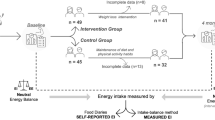Abstract
Three-day, rather than 7-day, food records are frequently used because mis-reporting of food intake is believed to increase with recording period. Data from the National Diet and Nutrition Survey of adults were used to explore trends in reported energy intake (REI) with day of recording and to compare average REIs from Thursday to Saturday and from Sunday to Tuesday to the complete 7-day record. Although REIs decreased from days 2 to 7, this was by a quantitatively insignificant 49 kJ per day (P=0.026) and well within the measurement error of recorded food intakes. Furthermore, REIs were lowest on the first recording day. The 3- and 7-day averages were similar (mean difference 0.039 (s.d.±1.0) MJ (NS), range −3.3 to +4.2 MJ). However, the difference was greater for those reporting higher than average energy intakes because of higher REIs on weekend days. Food intake reporting periods of longer than 3 days and ideally 7 days are preferable.
This is a preview of subscription content, access via your institution
Access options
Subscribe to this journal
Receive 12 print issues and online access
$259.00 per year
only $21.58 per issue
Buy this article
- Purchase on Springer Link
- Instant access to full article PDF
Prices may be subject to local taxes which are calculated during checkout

Similar content being viewed by others
References
Bingham SA (1987). The dietary assessment of individuals; methods, accuracy, new techniques and recommendations. Nutr Abstr Rev 57, 705–742.
Black AE, Cole TJ (2001). Biased over- or under-reporting is characteristic of individuals whether over time or by different assessment methods. J Am Diet Assoc 101, 70–80.
Bland JM, Altman DG (1986). Statistical methods for assessing agreement between two methods of clinical measurement. Lancet 8467, 307–310.
Borrelli R (1990). Collection of food intake data: a reappraisal of criteria for judging the methods. Br J Nutr 63, 411–417.
de Castro JM (1975). Meal pattern correlations: facts and artifacts. Physiol Behav 15, 13–15.
de Castro JM (1991). Weekly rhythms of spontaneous nutrient intake and meal pattern of humans. Physiol Behav 50, 729–738.
Donnelly JE, Jacobsen DJ, Heelan KS, Seip R, Smith S (2000). The effects of 18 months of intermittent vs continuous exercise on aerobic capacity, body weight and composition, and metabolic fitness in previously sedentary, moderately obese females. Int J Obes Relat Metab Disord 24, 566–572.
Goldberg GR, Black AE, Jebb SA, Cole TJ, Murgatroyd PR, Coward WA et al. (1991). Critical-evaluation of energy-intake data using fundamental principles of energy physiology.1. Derivation of cutoff limits to identify under-recording. Eur J Clin Nutr 45, 569–581.
Goris AHC, Meijer EP, Westerterp KR (2001). Repeated measurement of habitual food intake increases under-reporting and induces selective under-reporting. Br J Nutr 85, 629–634.
Henderson L, Gregory J, Irving K, Swan G (2003). The National Diet and Nutrition Survey: Adults Aged 19 to 64 Years. Vol. 2: Energy, Protein, Carbohydrate, Fat and Alcohol Intake. The Stationery Office: London.
Schofield WN (1985). Predicting basal metabolic rate, new standards and review of previous work. Hum Nutr Clin Nutr 39 (Suppl), 5–41.
Sondike SB, Copperman N, Jacobson MS (2003). Effects of a low-carbohydrate diet on weight loss and cardiovascular risk factors in overweight adolescents. J Pediat 142, 253–258.
Taggart N (1962). Diet, activity and body-weight – study of variations in a woman. Br J Nutr 16, 223–235.
Tarasuk V, Beaton GH (1991). The nature and individuality of within-subject variation in energy-intake. Am J Clin Nutr 54, 464–470.
Whybrow S, Harrison CLS, Mayer C, Stubbs RJ (2006). Effects of added fruits and vegetables on dietary intakes and body weight in Scottish adults. Br J Nutr 95, 496–503.
Yannakoulia M, Yiannakouris N, Bluher S, Matalas AL, Klimis-Zacas D, Mantzoros CS (2003). Body fat mass and macronutrient intake in relation to circulating soluble leptin receptor, free leptin index, adiponectin, and resistin concentrations in healthy humans. J Clin Endocrinol Metab 88, 1730–1736.
Young CM, Trulson MF (1960). Methodology for dietary studies in epidemiological surveys. II – strengths and weaknesses of existing methods. Am J Public Health 50 (6 Part 1), 803–814.
Author information
Authors and Affiliations
Corresponding author
Additional information
The original data creators, copyright holders and the UK Data Archive bear no responsibility for these further analysis and interpretation.
Guarantor: S Whybrow.
Contributors: SW conducted the analysis and wrote the manuscript. RJS contributed to the writing of the manuscript. GH carried out the statistical analysis. All authors participated in the interpretation and editing.
Rights and permissions
About this article
Cite this article
Whybrow, S., Horgan, G. & Stubbs, R. Low-energy reporting and duration of recording period. Eur J Clin Nutr 62, 1148–1150 (2008). https://doi.org/10.1038/sj.ejcn.1602826
Received:
Revised:
Accepted:
Published:
Issue Date:
DOI: https://doi.org/10.1038/sj.ejcn.1602826
Keywords
This article is cited by
-
Effect of different food groups on energy intake within and between individuals
European Journal of Nutrition (2022)
-
Is misreporting of dietary intake by weighed food records or 24-hour recalls food specific?
European Journal of Clinical Nutrition (2018)
-
The influence of a home-based exercise intervention on human health indices in individuals with chronic spinal cord injury (HOMEX-SCI): study protocol for a randomised controlled trial
Trials (2016)



